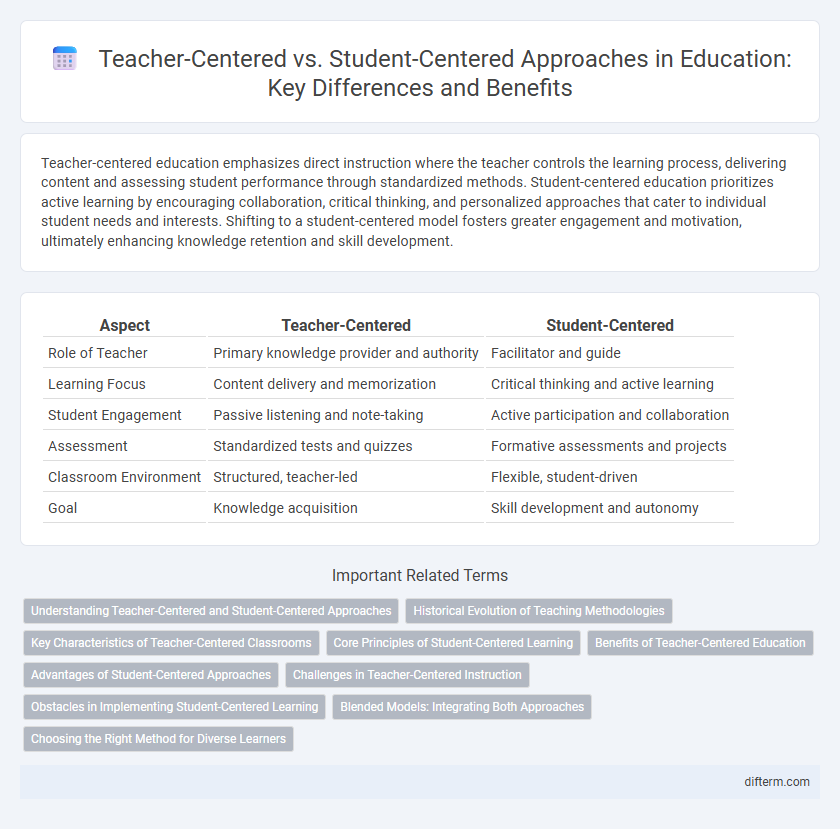Teacher-centered education emphasizes direct instruction where the teacher controls the learning process, delivering content and assessing student performance through standardized methods. Student-centered education prioritizes active learning by encouraging collaboration, critical thinking, and personalized approaches that cater to individual student needs and interests. Shifting to a student-centered model fosters greater engagement and motivation, ultimately enhancing knowledge retention and skill development.
Table of Comparison
| Aspect | Teacher-Centered | Student-Centered |
|---|---|---|
| Role of Teacher | Primary knowledge provider and authority | Facilitator and guide |
| Learning Focus | Content delivery and memorization | Critical thinking and active learning |
| Student Engagement | Passive listening and note-taking | Active participation and collaboration |
| Assessment | Standardized tests and quizzes | Formative assessments and projects |
| Classroom Environment | Structured, teacher-led | Flexible, student-driven |
| Goal | Knowledge acquisition | Skill development and autonomy |
Understanding Teacher-Centered and Student-Centered Approaches
Teacher-centered approaches prioritize direct instruction, where the teacher controls content delivery and classroom dynamics, focusing on knowledge transmission and standardized assessment outcomes. Student-centered approaches emphasize active learning, fostering critical thinking, collaboration, and personalized understanding through interactive activities and learner autonomy. Understanding these approaches helps educators balance structure with engagement to optimize educational effectiveness and accommodate diverse learning styles.
Historical Evolution of Teaching Methodologies
Teacher-centered methodologies dominated early educational systems, emphasizing direct instruction and rote memorization as primary learning tools. The 20th century witnessed a shift toward student-centered approaches, prioritizing active learning, critical thinking, and personalized instruction tailored to diverse student needs. This evolution reflects broader pedagogical movements such as constructivism and experiential learning, which have significantly influenced curriculum design and classroom dynamics.
Key Characteristics of Teacher-Centered Classrooms
Teacher-centered classrooms emphasize structured lessons where the teacher directs learning through lectures and standardized assessments, prioritizing content delivery over student interaction. This approach features a clear hierarchy, controlled pacing, and limited opportunities for collaborative or exploratory learning. Instruction is primarily teacher-led, with students expected to absorb information and demonstrate knowledge through exams and assignments.
Core Principles of Student-Centered Learning
Student-centered learning emphasizes active engagement, personalized instruction, and collaborative problem-solving to enhance critical thinking and deeper understanding. It prioritizes student autonomy, allowing learners to take ownership of their education while fostering a supportive environment tailored to diverse learning styles. This approach contrasts with teacher-centered methods that focus primarily on direct instruction and content delivery.
Benefits of Teacher-Centered Education
Teacher-centered education offers structured learning environments where instructors guide lessons, ensuring consistent curriculum coverage and efficient knowledge delivery. This approach enhances classroom management and allows teachers to tailor explanations to diverse student needs effectively. It also provides clear expectations and a disciplined setting that can improve student focus and academic performance.
Advantages of Student-Centered Approaches
Student-centered approaches enhance critical thinking and problem-solving skills by actively engaging learners in their educational process. These methods promote personalized learning, catering to diverse learning styles and fostering greater motivation and retention. Empirical studies indicate improved academic performance and higher student satisfaction in environments where learners take an active role in their education.
Challenges in Teacher-Centered Instruction
Teacher-centered instruction often faces challenges such as limited student engagement and reduced opportunities for critical thinking development. This approach can lead to passive learning, where students absorb information without actively participating or applying concepts practically. Educators may struggle to address diverse learning styles and maintain motivation, impacting overall academic performance and classroom dynamics.
Obstacles in Implementing Student-Centered Learning
Resistance from educators accustomed to traditional teacher-centered methods often hinders the implementation of student-centered learning, as it requires shifting control to students and adopting new facilitation skills. Limited resources and large class sizes create logistical challenges in personalizing instruction and promoting active student participation. Furthermore, standardized testing pressures push educators to prioritize content coverage over critical thinking, restricting opportunities for collaborative and inquiry-based learning approaches.
Blended Models: Integrating Both Approaches
Blended models in education integrate teacher-centered and student-centered approaches to optimize learning outcomes by balancing direct instruction with active student engagement. This hybrid method leverages teacher expertise for structured content delivery while promoting student autonomy and collaboration through interactive activities. Research indicates that blended instructional strategies enhance critical thinking, retention, and personalized learning experiences across diverse educational settings.
Choosing the Right Method for Diverse Learners
Teacher-centered approaches emphasize structured content delivery and clear guidance, ensuring foundational knowledge is uniformly conveyed. Student-centered methods prioritize active engagement, fostering critical thinking and personalized learning experiences to accommodate diverse cognitive styles. Selecting the right instructional strategy depends on learners' needs, content complexity, and desired outcomes, balancing direct instruction with opportunities for exploration.
teacher-centered vs student-centered Infographic

 difterm.com
difterm.com